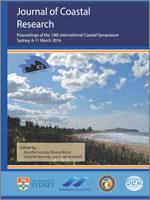Balouin, Y.; Longueville, F., and Colombet, Y., 2016. Video assessment of nearshore and beach evolution following the deployment of a geotextile wave breaker. In: Vila-Concejo, A.; Bruce, E.; Kennedy, D.M., and McCarroll, R.J. (eds.), Proceedings of the 14th International Coastal Symposium (Sydney, Australia). Journal of Coastal Research, Special Issue, No. 75, pp. 617–621. Coconut Creek (Florida), ISSN 0749-0208.
The feedback on the use of submerged structures for beach protection is still scarce, and the shoreline response to structures is still poorly understood at present. Most of the studies presents structures close to the shoreline without significant morphologies on the shoreface that could interact with it. On the Lido of Sète, a narrow coastal barrier facing the Mediterranean Sea, an experimentation of beach protection using a submerged geotextile structure is undertaken. The structure was deployed in 2013, and to analyse nearshore dynamics, an ARGUS video system was installed in 2011. Video-derived shoreline, bar crest position, alongshore currents, swash processes, were used to assess the natural dynamics and to evaluate the evolution after the installation of the 850 m long structure.
The monitoring permitted to describe a rapid dynamics of crescentic nearshore bars. Processes of longshore migration, linearization, as well as a strong coupling between bar dynamics and shoreline sinuosities were described. After the deployment of the geotextile, a progressive linearization and rotation of the nearshore bar (parallel to the tube) was observed. This process induced a progressive rotation of the shoreline and an important beach enlargement. The 3D patterns, both in the bar and emerged beach progressively disappeared. With this new beach morphology, storm run-up is more regular alongshore, and only major events can reach the dune front and generate impacts. This field experiment provide an interesting feedback on morphological response following the deployment of a submerged structure on a shoreface characterized by an important nearshore bar dynamics.





